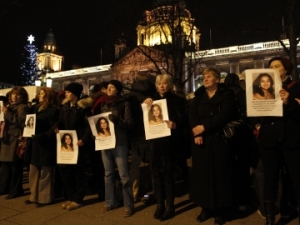Savita Halappanavar would be alive today if her seventeen-week pregnancy had been terminated. On 21st October, she was admitted to Galway’s University Hospital suffering severe back pain, and over the coming days it became clear that her pregnancy was miscarrying. Amniotic fluid was leaking rapidly, and her cervix was fully dilated – leaving her vulnerable to deadly infection. Ms Halappanavar was left for days, in pain, given woefully inadequate treatment (antibiotics) as her health deteriorated rapidly. It was plain as day that she urgently needed to have her pregnancy terminated properly in order to save her life – but Doctors couldn’t act. She asked for a termination; she was told: “Ireland is a Catholic country”. Ms Halappanavar stated the case that she was neither Irish, nor a Catholic, but to no avail. The Doctors hands were tied, and tragically, Savita Halappanavar succumbed to infection and died on 28th October, 2012. She was just 31 years old.
On the surface, this reads like an anecdote of Medieval child-birth. I have certainly read articles likening it to this era. But this is worse. Our Medieval ancestors had no hope of saving their loved ones from the dangers of childbirth, they simply didn’t have the medical know-how. But we do, and Ms Halappanavar was left to die regardless. How could this have happened in the 21st century? Ireland is not a third world country, it isn’t being run by despot dictators, and on the surface, it is not a theocracy, under the thumb of religious zealots. The answer is more convoluted than that. It is the Irish Government, and the confusing state of the country’s abortion laws.
Twenty years ago, following the case of “X” (a teenage girl who’d become pregnant after suffering rape), the Dail were given a mandate by the people of this country to carry out terminations in limited circumstances (rape cases, and cases where the mother’s life was clearly in danger). However, since that case, successive Irish Governments have dodged enforcement and shirked the abortion issue altogether. The European Court of Human Rights have condemned the Irish Government for this very reason, precisely for their lack of clarity and refusal to act. Still, the Irish Government did nothing.
Now, here we are in 2012, and a woman has died. A death that was as predictable as it was preventable. But, it was not the Doctors who killed her, it was the Irish state with their hopelessly ambiguous abortion laws. If they had only acted to clarify the laws surrounding terminations then the Doctors at Galway University Hospital would have known where they stood in the law, and Ms Halappanavar would be alive today. It really is that simple. Instead, they (the Governments) have allowed themselves to be dominated by Catholic zealots who’d rather forsake a living, breathing human being for the sake of a ball of cells. What makes an even bigger mockery of the “pro-life” argument is that Ms Halappanavar’s pregnancy had ended, and there wasn’t even a viable foetus to save. Two deaths occurred that day, and I doubt the “pro-lifers” care a fig for either of them – they will carry on their propaganda war regardless.
However, no more are the religious zealots getting it all their own way. In the aftermath of Ms Halappanavar’s death, there has been a wave of protests and vigils across Ireland, and in Britain. Once again, the people of Ireland are demanding clarity and reform on the emotive issue of abortion before another mother’s life is taken. Surely now, the Irish Government must act? They cannot dodge this issue, they cannot ignore the voices of women crying out for fair treatment and control of their own bodies? Our ovaries are not the property of the State, and it’s time the Government stood up to the fanatics who seek to control other people’s lives. My answer to these “pro-lifers” is a simple one: if you dislike abortion, don’t have one.
I personally attended a vigil to remember Savita Halappanavar outside Belfast City Hall. I was one of a large crowd, holing placards bearing a simple picture of the deceased and a simple lit candle. There was no sloganeering, no shouting or unrest. There were numerous men as well as women; and a beautiful lamenting mantra of “Om Shanti Om” sung as a mark of respect for Ms Halappanavar’s Hindu background. But despite the atmosphere of solemn remembrance, there was a strong undercurrent of anger. Anger that a woman could die like this in Ireland. Anger that women here are not afforded the same respect and dignity that women in England are. Anger that women’s bodies are still the property of the state. The message sent out to both the Dail and the Stormont Assembley here in Northern Ireland was clear: we need reforms and we need them now. If the status quo continues, there will be more deaths, more women’s lives laid to waste because of religious bigotry.
To conclude this article, I would like to quote Ms Halappanavar’s mother who spoke about the tragic death of her daughter to Indian media: “In an attempt to save a four month old foetus, they killed my 30 year old daughter. How is that fair, you tell me?” This, I am afraid, will still be lost on the pro-life zealots who hold this country’s women to ransom.

